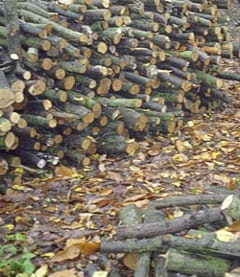by Lauren Chase Rowell
I was asked to come up with five permaculture suggestions as to what could be done with the spaces in our gardens that remain empty after the harvest. These are the open areas in our annual vegetable, herb, and flower growing spaces that appear after the first frost and then often remain unused until spring planting season.
I had to think about this, because there are several conditions I am assuming are best practices among practitioners of permaculture. So before making suggestions on how to use these areas, I would like to share my assumptions regarding the kinds of practices that outline a permaculturist’s annual food system practices:
- First, I hope soils are not left bare to the elements over the winter, but instead are covered with natural, on-site mulches such as grass clippings, shredded or whole leaves, or sheet mulches.
- Second, I hope that these unused areas are surrounded by a generous amount of perennial edges: nitrogen fixers, dynamic accumulators, and pollinator plants to bring in nutrients, invertebrates, reptiles, amphibians, birds, and such, as well as stacking functions to soften winds, help catch rain water through increased filtration and infiltration, and create heat-trap microclimates.
- My third hope for the permaculture gardener is that the remnants of the annual plants are left in place over the winter, or at most snipped above ground level to leave the root system to rot in place, amplifying organic matter where it is needed, while providing channels for air exchange, CO2 release, and deeper water infiltration over time.
- Finally, keep in mind the future use of the garden space. After harvest and several frosts, the annual production spaces in my gardens are small in size, varying from 5’x 5’ to rarely bigger than 10’x10’. I rotate the different families of vegetables that I grow yearly, namely the nightshades (eggplant, tomatoes, peppers and potatoes), alliums (scallions, onions, and leeks), the cole crops (the entire cabbage family), cucurbits (squashes, gourds, and pumpkins), and the chenopods (spinach, beets, lamb’s quarters, and chard). A five year rotation keeps plant diseases in check, deters specific insects from building up population levels, and disallows the same plant type to continually draw the same nutrients from the soil, while plants in the rotation leave behind useful biochemical components for others to use. The reason I mention this is because for a few of the suggestions below, a careful awareness is required when introducing a new plant or a new function from outside the rotation. With careful planning you may be able to gain benefits without sacrificing your annual production space or outputs.
With these gardening basics in place and in mind, here are a few suggestions for using these seasonally vacant spaces creatively with a permaculture spin.
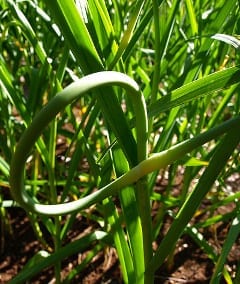 Plant garlic. Garlic is planted in the fall to achieve a July harvest. If carefully planned, a new crop, especially one with less than 75 or so growing days, can follow the garlic. Garlic can positively interrupt the rotational cycle in alignment with quick growing crops such as beets and chards, or heat resistant varieties of lettuces, scallions, and fast growing herbs like cilantro and basil. Garlic is loaded with health benefits, and adapts to your soil through bio-elasticity, improving itself through selection of bulbs for next year’s planting. Stiff-necked garlic adds the benefit of mouth-watering scapes at a time when the storage of garlic in our closets and cellars is depleted, and our bodies are craving fresh garlic-goodness.
Plant garlic. Garlic is planted in the fall to achieve a July harvest. If carefully planned, a new crop, especially one with less than 75 or so growing days, can follow the garlic. Garlic can positively interrupt the rotational cycle in alignment with quick growing crops such as beets and chards, or heat resistant varieties of lettuces, scallions, and fast growing herbs like cilantro and basil. Garlic is loaded with health benefits, and adapts to your soil through bio-elasticity, improving itself through selection of bulbs for next year’s planting. Stiff-necked garlic adds the benefit of mouth-watering scapes at a time when the storage of garlic in our closets and cellars is depleted, and our bodies are craving fresh garlic-goodness.
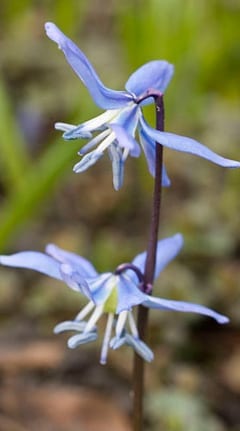 Plant bulbs on the edges. A row of bulbs only takes 12 inches of width-space, leaving the rest of the area enhanced, but ready for spring planting. By taking this bit of space, you’ll be adding value to the next season by bringing in the early emerging pollinators, adding diversity to the edges, and refreshing your table with big, fat bouquets of flowers. More importantly and specifically, our open annual bedding areas are great spots to transplant the already existing bulbs in our yards that become shaded and overcrowded. These bulbs that are diminishing in size each year can be dug up, transplanted in the open sunny area, revived to full potential, and put back in the landscape in areas that need early spring color and ecological enhancement. My favorite work-horse bulbs are daffodils, muscari, squill, the species tulips, and the alliums.
Plant bulbs on the edges. A row of bulbs only takes 12 inches of width-space, leaving the rest of the area enhanced, but ready for spring planting. By taking this bit of space, you’ll be adding value to the next season by bringing in the early emerging pollinators, adding diversity to the edges, and refreshing your table with big, fat bouquets of flowers. More importantly and specifically, our open annual bedding areas are great spots to transplant the already existing bulbs in our yards that become shaded and overcrowded. These bulbs that are diminishing in size each year can be dug up, transplanted in the open sunny area, revived to full potential, and put back in the landscape in areas that need early spring color and ecological enhancement. My favorite work-horse bulbs are daffodils, muscari, squill, the species tulips, and the alliums.
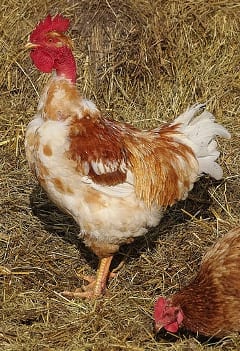 Improve open annual areas with poultry. Small numbers of chickens and ducks can be penned upon these gardens using easily movable, solar electric mesh fencing. For this reason, I have a few different fence sizes and lengths, that I set up intermittently so the chickens and/or ducks can poke and peck, gaining health through eating seeds, worms and grubs, and other unknown delicacies. The trick is to move them in a day or so, depending on the size of the area and the number of birds; through keen observation, a permaculturist can gain a nice layer of fertilizer this way without compaction. The trade off for the time spent moving fences is a win-win, a boost for the poultry before a long winter, and a natural amendment to the food system. I use ducks exclusively for this, but chickens can work, too, as long as you tuck the soil back in for the winter if existing mulches have been disturbed through the scratching nature of the chicken.
Improve open annual areas with poultry. Small numbers of chickens and ducks can be penned upon these gardens using easily movable, solar electric mesh fencing. For this reason, I have a few different fence sizes and lengths, that I set up intermittently so the chickens and/or ducks can poke and peck, gaining health through eating seeds, worms and grubs, and other unknown delicacies. The trick is to move them in a day or so, depending on the size of the area and the number of birds; through keen observation, a permaculturist can gain a nice layer of fertilizer this way without compaction. The trade off for the time spent moving fences is a win-win, a boost for the poultry before a long winter, and a natural amendment to the food system. I use ducks exclusively for this, but chickens can work, too, as long as you tuck the soil back in for the winter if existing mulches have been disturbed through the scratching nature of the chicken.
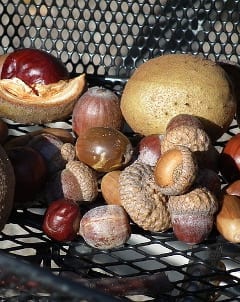 Develop a nursery. This fourth suggestion requires a glimpse at one of my kitchen windowsills. It is full of bowls of nuts, seeds, and occasional mushroom species that I have collected this year. I keep them on the windowsill so I am reminded to plant them this fall to take advantage of the freeze-thaw cycles for natural scarification and the break of seed dormancy over the winter months. Since our annual production beds are mostly in full sun and in the open, it is a perfect spot to line out a row of walnuts, chestnut, hazelnut, and acorns. I have seed from bristly sarsaparilla, butterfly weed, lupine, and baptisia, which are all plants I would like to have more of in my landscape. From magnolia seed to the tiniest mushroom spores, I like to challenge my propagation abilities and pique my curiosity by giving up a little space for a nursery bed. I use old blinds to make labels that I can push a good 8-10 inches into the ground while recording other pertinent information as to the genetic locality of the seed, the species, and the date. The labels do not blow away, and I am visually reminded to keep an eye on this area because some nuts and seeds take longer than a season, or even a year, to germinate.
Develop a nursery. This fourth suggestion requires a glimpse at one of my kitchen windowsills. It is full of bowls of nuts, seeds, and occasional mushroom species that I have collected this year. I keep them on the windowsill so I am reminded to plant them this fall to take advantage of the freeze-thaw cycles for natural scarification and the break of seed dormancy over the winter months. Since our annual production beds are mostly in full sun and in the open, it is a perfect spot to line out a row of walnuts, chestnut, hazelnut, and acorns. I have seed from bristly sarsaparilla, butterfly weed, lupine, and baptisia, which are all plants I would like to have more of in my landscape. From magnolia seed to the tiniest mushroom spores, I like to challenge my propagation abilities and pique my curiosity by giving up a little space for a nursery bed. I use old blinds to make labels that I can push a good 8-10 inches into the ground while recording other pertinent information as to the genetic locality of the seed, the species, and the date. The labels do not blow away, and I am visually reminded to keep an eye on this area because some nuts and seeds take longer than a season, or even a year, to germinate.
Consider the benefits of storage. The fifth and last suggestion I have concerns using the empty space for storage. I like to capture and store on-site resources while they are readily available – leaves and twigs, old bales of mulch hay, a wheel barrel or two of bark from cutting firewood, and clippings from minor garden clean-ups. Gathering and storing these resources makes my life easier in the upcoming season, and using open areas in the landscape for resource storage offers benefits aside from convenience. Twigs are packed with nutrients and barks from firewood bring spores of fungi into the vacant garden space. Old, wet bales of hay break down over the winter adding to the soil the stable humus components found in straw. Beneath these on-site resources, nutrient inoculated bio-char can be added as a layer against the soil in the fall. Over the winter and during the time transplants are dug into the earth in the spring, these different organic materials are gently incorporated into the top inches of soil without tilling and the use of fossil fuels.
Storing the last of the lawn cuttings on open beds offers benefits, too. Cutting the grass one final time in November also shreds the leaves that lie upon it, making for a heavier, ‘green and brown’ compost ratio, which stays in place over the winter for the most part. I layer it on about 6-8’’ thick, and plant right through it in the spring, and it all settles down through decomposition to about a 3’’ thickness at planting time. The worms love it and work pulling it down into their chambers very late into the season. In the spring, if I move this mulch aside gently, there’s a rich layer of worm castings with a near 7pH, often one inch thick, bringing a balanced fertility into the soil ecosystem.
The vacant areas of annual plant production left unused can also serve to store bulky, temporary items like rain barrels, solar dryers, and some extra cordwood if need be. Annual garden areas in permaculture food systems are usually near to the kitchen, or in the zone one and two sectors. Storage here makes access convenient for the occasional winter use of the solar dehydrator, or an armload of wood for a stubborn spring.
If we think creatively, uses can be found for anything, even the abandoned-‘til-spring spaces in our annual gardens. Bill Mollison, the originator of permaculture, said our designs and use of patterns for our homes and landscapes are limited only by our imaginations!
About the Author
Lauren Chase Rowell is current steward of Dalton’s Pasture in Nottingham, NH, a certified NH Landscape Professional (NHCLP), and a certified permaculture designer and educator. Lauren has been practicing and teaching ecological landscape design and horticulture for over 25 years, at UNH and NH community colleges. As an educator, her classroom instruction is informed by 35 years of experience in regenerative food growing and preservation, medicinal herbs and foraging, and the importance of NH biodiversity in local, resilient landscape settings. Lauren embraces the practical application of permaculture in earth-centered living and design, while simultaneously integrating contemplative practices into her holistic teaching-style. She is an author and has been featured twice on NH’s Chronicle for her ecological approach to earth-friendly, life-style choices, and careful use of resources. She is owner of Outdoor Rooms Permaculture Landscape Design Services.

